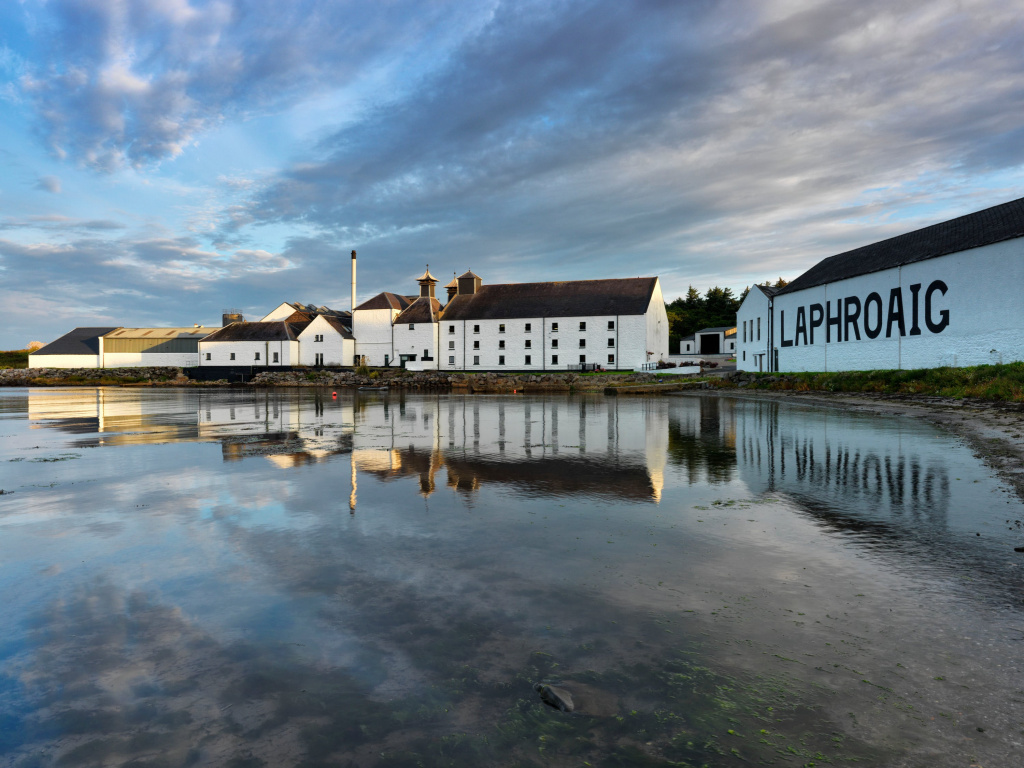Just two distilleries made the Top 12 of both listings, so let’s begin with them.
Glenmorangie
The famous old distillery in the north Highlands, close to the town of Tain, is a popular choice. Just one hour’s drive north of Inverness and oozing with tradition. Glenmorangie maintains a quaint feel despite several modernisations to raise production levels to meet consumer demands. The views across the Dornoch Firth and the impressive still house with its 12 tall and elegant stills are the highlights. If you are lucky then you may also get to see The Lighthouse – a new innovative craft distillery on the site.
Laphroaig, Islay
The iconic Islay distillery attracts close to 30,000 visitors each year. This is partly fuelled by its ‘Friends of Laphroaig’ sign-up club that is the largest such whisky membership club in the world. The setting is lovely with the distillery sitting on a small bay. Everything feels traditional and it is one of the few places in Scotland where you can witness traditional floor malting and the drying of barley with peat smoke. This will change soon with a major expansion planned, but hopefully the vibe can remain.
Several new artisanal distilleries featured
Especially on the Milroy’s/Good Brothers list. Interestingly, most of these were in remote spots of the Highlands or on Hebridean islands. From experience, you often get the warmest of welcomes in such locations. There is an appreciation from staff of the effort made and dedication from the whisky tourist to reach such a place.
Highlights here definitely include the Isle of Harris and Isle of Raasay distilleries. These are (unsurprisingly) on the islands of Harris in the Outer Hebrides and Raasay near Skye. Both have been established and started whisky production in the last nine years. Slightly older, and one of the pioneers of the craft whisky movement in Scotland, is the family-owned farm distillery of Kilchoman on Islay. Another is the organic eco-friendly distillery of Nc’ nean on the isolated Morvern peninsula on the west coast.
Bigger and more well-known names
The Cask Connoisseur list features Glenfiddich, and they do not get bigger and more well-known in Scotch single malt terms than the Speyside giant. Elsewhere, each whisky producing region is represented. Glenkinchie in the Lowlands is highly recommended, alongside Springbank in Campbeltown (definitely one of the most ‘hands on’ places you can visit). Glengoyne in the Highlands, Glen Moray in Speyside, plus Ardbeg (a perennial award-winner for its visitor centre) and Bruichladdich on Islay also feature and are well worth a visit.
For more information about Scotland’s whisky producing regions and the different distilleries that Whisky 1901 works with, get in contact with one of the team here.
**Disclaimer**
Whisky cask investments are unregulated in the UK. The value of investments is variable and can go down as well as up. You have 14 days to change your mind and request a full refund under our cooling-off period. The volume of spirit will decrease over time (known as “the Angels’ share”). “New Make” spirit has to be matured for 3 years, during which time its alcoholic strength could be reduced. However, for the product to be classed as “whisky”, it must retain a minimum strength of 40%. Fees apply, see terms and conditions for details and terms around exiting your investment.
An investor may get back less than the amount invested. Information on past performance, where given, is not necessarily a guide to future performance. The capital invested can fluctuate and the price of casks can go down as well as up and is not guaranteed. The investments and services offered by us may not be suitable for all investors. If you have any doubts as to the merits of an investment, you should seek advice from an independent financial advisor. The Whisky 1901 Ltd sale price includes a discretionary markup to cover the cost of services provided, including but not limited to, storage, movement and maintenance of casks, insurance, front and back-office software.





